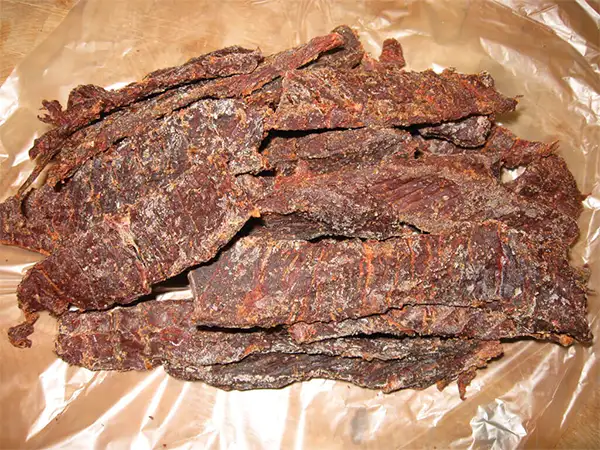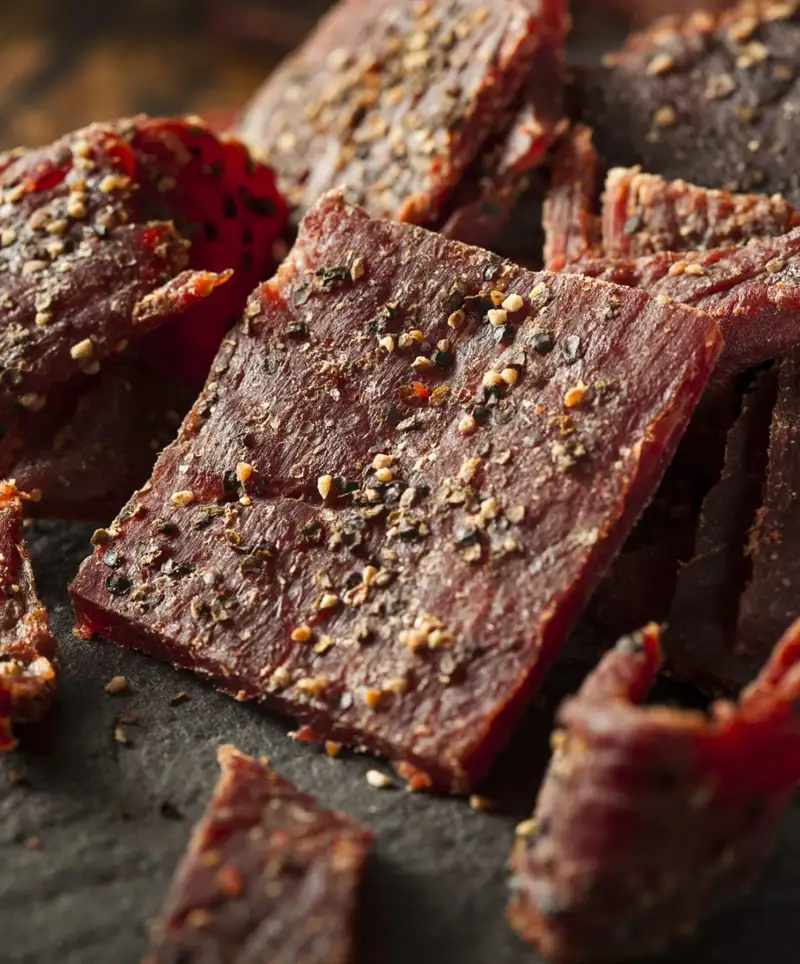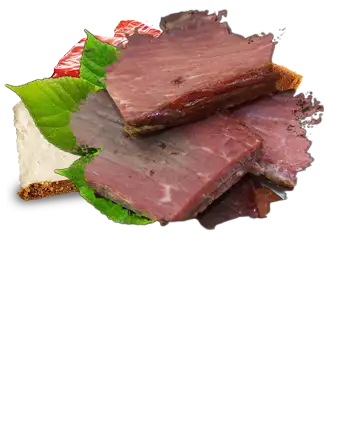A Flavorful Journey
Welcome to the delectably savory world of National Craft Jerky Day! This annual culinary celebration unites jerky aficionados and adventurous food lovers from all corners of the globe. It's not just a day; it's an homage to one of humanity's oldest and most versatile snacks - jerky. This dried delight, steeped in tradition and bursting with flavors, has been satisfying taste buds for centuries. In this article, we're embarking on an exciting journey through the rich history and diverse types of craft jerky. We'll unwrap the fascinating evolution of this snack from its humble beginnings to its current status as a gourmet treat. Prepare to have your culinary curiosity piqued and your funny bones tickled as we delve into a world where flavor meets fun, and every bite tells a story. Get ready to discover surprising fun facts, and mouth-watering varieties, and maybe even find your new favorite snack as we celebrate the art and craft  of jerky on National Craft Jerky Day.
of jerky on National Craft Jerky Day.
A Bit of History
The story of beef jerky is as flavorful and diverse as the snack itself. Tracing its roots back to ancient times, jerky has been a staple in the diets of many cultures around the world.
The concept of jerky began with the need to preserve meat. Long before refrigeration, ancient civilizations discovered that meat could be preserved through a combination of drying and salting. The Quechua people, an indigenous group from South America, were among the pioneers of this technique. They called this preserved meat "ch'arki," from which the term "jerky" is derived. This method involved slicing the meat thinly, curing it with salt, and then drying it in the sun or over a fire. The result was a durable, lightweight food source that could be stored for extended periods - an essential attribute for nomadic lifestyles and long journeys.
The practice of making jerky spread across continents, adapted by different cultures according to their unique climates, available meats, and flavor preferences. In North America, Native American tribes created their own version of jerky using game like deer, elk, and buffalo. This not only provided sustenance for their own communities but also became a valuable trading commodity.
The arrival of European settlers in the Americas introduced new flavors and preservation methods to jerky making. They brought with them spices and seasonings previously unknown in the New World, which were soon incorporated into jerky recipes. The fusion of these new ingredients with traditional Native American jerky-making techniques led to an even wider variety of flavors and styles.
With the advent of the Industrial Revolution and the modern era, jerky production evolved from a home-based preservation method to a commercial enterprise. The introduction of modern food processing and packaging technologies in the 20th century transformed jerky into a convenient, commercially available snack.
In recent years, there has been a resurgence of interest in artisanal and gourmet jerky. This movement has emphasized high-quality ingredients, traditional drying methods, and innovative flavors, catering to a more health-conscious and flavor-seeking consumer. Today's craft jerky producers experiment with a range of meats, including traditional beef, exotic game, and even plant-based alternatives, offering an array of flavors from classic to contemporary.
Cultural Significance
Throughout its history, jerky has been more than just a food item; it has been a symbol of survival, a trade commodity, and a cultural artifact. Its ability to transcend geographical and cultural boundaries while adapting to local tastes and traditions is a testament to its enduring appeal.
As we celebrate National Craft Jerky Day, we honor not just a snack, but a rich culinary tradition that has stood the test of time, evolving from a necessity of preservation to a modern gourmet delicacy.
What Makes Craft Jerky Special?
Craft jerky distinguishes itself in the world of snacks with its artisanal quality and exceptional flavors. This specialty treat goes far beyond the average jerky found on grocery store shelves. Here's a deeper look into what makes craft jerky so special:
Handcrafted with Care: The essence of craft jerky lies in its handcrafted nature. Unlike mass-produced jerky, craft jerky is often made in small batches. This artisanal approach allows for meticulous attention to detail at every step of the process, from selecting ingredients to packaging the final product. Each batch is a labor of love, imbued with the passion and care of its maker.
Premium Quality Ingredients: Craft jerky begins with the selection of premium meats. Artisans typically choose high-quality cuts, often sourced from local farms where animals are raised ethically and sustainably. This focus on quality extends to every ingredient used, from the marinades to the seasonings. The result is a product that not only tastes better but also aligns with higher standards of animal welfare and environmental responsibility.
Unique Seasoning Blends: One of the hallmarks of craft jerky is the creativity and diversity of its flavors. Artisans experiment with a variety of seasoning blends, drawing inspiration from global cuisines and culinary trends. These unique combinations of herbs, spices, and other flavorings create a taste profile that is both complex and distinctive. From smoky and savory to sweet and spicy, craft jerky offers a palate of flavors that cater to every taste preference.
Artisanal Drying Techniques: The drying process is crucial in crafting the perfect jerky. Artisans use methods that have been honed over time, often combining traditional techniques with modern technology. This careful drying not only preserves the meat but also enhances its flavors and textures. Whether it's slow-drying at low temperatures to retain tenderness or using specific woods for smoking to add depth of flavor, each step is thoughtfully executed.
A Culinary Experience: Craft jerky transcends the notion of being just a snack. It's an immersive culinary experience. Each piece tells a story of tradition, innovation, and craftsmanship. For the consumer, it's not just about satisfying hunger but about engaging in a sensory journey that connects them to the artistry behind the product.
Personal Touch and Connection: Lastly, craft jerky often comes with a personal touch. Many craft jerky makers are small business owners who interact directly with their customers, sharing stories about their products and the inspiration behind them. This connection adds an extra layer of enjoyment to the jerky-eating experience, making it more than just a transaction but a relationship between the artisan and the consumer.
Craft jerky stands out for its quality, creativity, and the personal dedication of its makers. It represents a fusion of culinary art and tradition, offering a snack experience that is both indulgent and memorable.
Jerky isn't only about beef anymore. From classic beef to exotic meats like alligator and kangaroo, there's a whole zoo of options. Flavors range from sweet and tangy to fiery hot, with seasonings like teriyaki, black pepper, and ghost chili. Each bite is a new adventure!
Besides being delicious, jerky is a powerhouse of nutrition. It's packed with protein, making it a favorite among athletes and outdoor enthusiasts. Low in fat and carbs, it's also a guilt-free snack for those watching their waistline.
DIY Jerky
 Creating your own jerky at home is an enjoyable and rewarding process. It allows you to experiment with flavors and enjoy the satisfaction of making a snack from scratch. One of the crucial steps in jerky making is drying the meat. Here’s a guide to help you through this process:
Creating your own jerky at home is an enjoyable and rewarding process. It allows you to experiment with flavors and enjoy the satisfaction of making a snack from scratch. One of the crucial steps in jerky making is drying the meat. Here’s a guide to help you through this process:
Selecting the Right Cut: Start with a good cut of meat. Lean cuts are best for jerky as they have less fat, which can cause the jerky to spoil faster. Popular choices include beef sirloin, flank steak, or round cuts. Trim any visible fat for optimal results.
Preparing the Meat
- Slice the Meat: Thin, consistent slices are key. Aim for slices about 1/8 to 1/4 inch thick. If you find it difficult to slice, try freezing the meat slightly first.
- Marinate: Marinating adds flavor and tenderizes the meat. You can get creative here, using anything from simple salt and pepper to complex blends of soy sauce, Worcestershire sauce, garlic, spices, and even a bit of sweetness like honey or brown sugar. Marinate for at least a few hours, preferably overnight, for the flavors to fully penetrate.
Drying is where the magic happens, turning your seasoned meat into jerky. There are several methods you can use:
Oven Drying
- Set Up: Preheat your oven to the lowest setting, usually around 170°F (75°C).
- Arrange the Meat: Place meat slices on a wire rack over a baking sheet. This allows air to circulate around the meat, drying it evenly.
- Dry: Leave the oven door slightly ajar to allow moisture to escape. Bake for 3-4 hours, flipping the slices halfway through. The jerky is done when it bends and cracks but does not break.
Dehydrator
- Set Up: If you have a dehydrator, this is an excellent option for making jerky. Follow the manufacturer's instructions for setup.
- Arrange the Meat: Lay out the meat slices in single layers on the dehydrator trays.
- Dry: Set the dehydrator to 160°F (71°C). Drying times can vary from 4 to 8 hours depending on the thickness of the meat and the dehydrator model. Check regularly for the desired texture.
Air Drying (Traditional Method)
- Prepare: This method works best in a dry, warm climate. You'll need a clean, airy space where you can hang the meat.
- Hang the Meat: Use strings to hang the meat slices, ensuring they don't touch each other.
- Dry: Leave the meat to air dry. This can take several days and is best done in a screened area to keep insects and pests away.
The key to perfect jerky is the right level of dryness. The jerky should be leathery and bendable, not brittle. It should crack but not snap when bent.
Once cooled, store your homemade jerky in an airtight container. It can last up to two weeks at room temperature, a month in the refrigerator, and several months if frozen.
Making your own jerky is a blend of art and science. It requires patience and a bit of trial and error, but the end result is a delicious, personalized snack you can be proud of. Celebrate National Craft Jerky Day by delving into this delightful DIY culinary project!
Fun Facts to Chew On
- Astronauts have taken beef jerky into space as a high-protein snack.
- The world’s largest piece of jerky ever made weighed over 300 pounds!
- Jerky can last up to two years if stored properly, making it the ultimate survival food.
National Craft Jerky Day isn't just about snacking; it's a celebration of tradition, innovation, and flavor. Whether you're a jerky connoisseur or new to the game, this day offers a delicious opportunity to explore the rich world of craft jerky.
So, grab a piece of your favorite jerky, and join the celebration. Happy National Craft Jerky Day!
Please Share our Content






 of jerky on National Craft Jerky Day.
of jerky on National Craft Jerky Day. Creating your own jerky at home is an enjoyable and rewarding process. It allows you to experiment with flavors and enjoy the satisfaction of making a snack from scratch. One of the crucial steps in jerky making is drying the meat. Here’s a guide to help you through this process:
Creating your own jerky at home is an enjoyable and rewarding process. It allows you to experiment with flavors and enjoy the satisfaction of making a snack from scratch. One of the crucial steps in jerky making is drying the meat. Here’s a guide to help you through this process:








 "Sláinte!" is a traditional Irish expression used as a toast, equivalent to "Cheers!" in English.
"Sláinte!" is a traditional Irish expression used as a toast, equivalent to "Cheers!" in English.